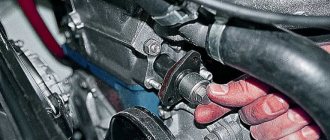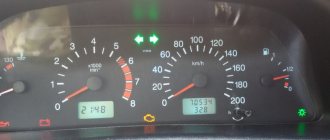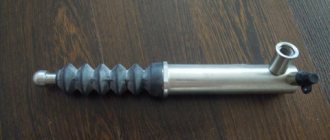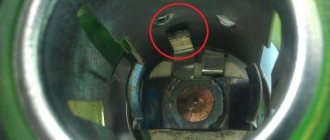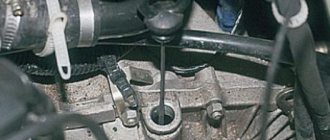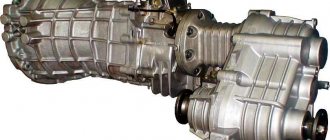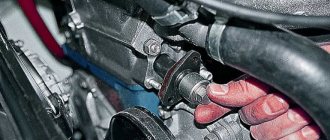Description of the hydraulic compensator device and its principle of operation
Hydraulic compensators are designed to automatically regulate the thermal gap between the valves and the engine camshaft. The hydraulic attachment is provided by oil, which enters the expansion joints under pressure, and a complex and incredibly precise set of springs provides the necessary clearance.
Hydraulic compensators, which have been installed on Chevrolet Niva in recent years, give them a tangible advantage:
- there is no need to periodically adjust the valves;
- now the timing belt works more clearly and correctly;
- The noise when the engine is running has decreased significantly; it begins to knock less;
- The service life of timing parts has increased significantly.
Main details of the unit:
- Plunger pair.
- Frame.
- Plunger bushing.
- Plunger spring.
- Plunger ball valve.
The operating principle of the unit is relatively simple and consists of three main functions:
- There remains a small gap between the camshaft cam and the compensator, which is filled with oil. The plunger spring pushes the plunger out of the sleeve, the oil fills the gap under pressure, reaches the desired level, and the ball valve shuts off the oil supply. After these actions, the gap disappears.
- By turning, the cam moves the compensator down. Due to the accumulated oil, the plunger pair becomes rigid and presses on the valve, opening it.
- As the plunger moves down, it loses some oil and its pressure drops. As the cam moves further, the cycle repeats.
How to identify a faulty hydraulic compensator
To determine a knocking compensator, you need to use a screwdriver, which is used as a lever, to press on those “hydraulics” that are at TDC (top dead center). If the hydraulic compensator fails under pressure from a screwdriver, it means it is not adjusted. If you want to make sure of this, quickly press with a screwdriver and you will hear a characteristic sound.
Typical faults
Problems with hydraulic compensators arise for two reasons. It is not difficult to identify them - this is either a mechanical breakdown of the unit itself, its destruction, or a breakdown of the oil supply system to the compensator.
In the first case, a common cause is wear of the plunger pair. This is an inevitable process that depends only on the operating time of the unit and the quality of the metal from which it is made. Factory defects cannot be ruled out; this is extremely rare, but it does happen. Replacing this part costs the same as replacing a regular consumable.
In the second case, the oil level in the engine matters; it can be too low or too high. The oil filter may be dirty and dirt may have entered the channels. Untimely oil change is another reason for unstable operation of the unit.
Do not forget about the correct selection of oil - use oils of the same type and preferably from the same manufacturer. The consequences of failure to comply with these rules can be disastrous; saving on oil can cost you money to repair the engine.
How to check and discharge the hydraulic compensator
To ensure that hydraulic compensators do not create problems, you must follow simple rules:
- The engine must be as clean as possible. We don’t mean a shiny filter cap, but clean oil, clean filters, replacing them in a timely manner and using only certified, expensive, high-quality oil.
- Flush the engine after changing the oil, but not with fast-acting rocket additives. This will only contribute to coking of the technological gaps in the hydraulic compensators.
- When knocking occurs in the compensators, you need to know how to discharge the hydraulic compensator. That is, bleed the air, remove the air plug that may form during installation. This can be done using a simple clamp - before installation, you need to fill the compensator with oil and use a clamp to compress it until the air is completely released.
- After installing the compensators, it is necessary to crank the engine crankshaft 4-5 times before starting, then wait 15-20 minutes. Only then can the plungers automatically take their working position.
- Hydraulic compensators must be replaced after 120-180 thousand mileage and can only be replaced as a set.
Also interesting: Chevrolet Niva engines: characteristics and capabilities
The most common cause of knocking in hydraulic compensators is airing. Air can enter the plunger either due to excessive wear or after the vehicle has not been used for a long time.
In this case, it is necessary to let the warmed-up engine run without load at medium stable speeds for three to four minutes, then at variable speeds in the region of 3-3.5 thousand revolutions, and after that the engine should run at idle for about a minute.
This is all you need to know in order for hydraulic compensators to serve for a long time and perform their functions without problems. Keep your engine running quiet and good luck to everyone on the road!
Causes of knocking hydraulic compensators
The knocking sound of Chevrolet Niva hydraulic compensators can be easily detected by ear; it knocks at a frequency half the engine speed. It can knock both on a cold engine and on a hot one, and the reasons for this are different.
Reasons for knocking when cold:
- Thick oil. As the engine warms up, the oil heats up, becomes thinner, and the knocking noise goes away.
- Dirt. A bad filter or old oil can cause dirt to get into the channels and holes and clog them.
- Worn or broken plunger. The cause may be natural wear or abrasive contaminants that have entered the oil.
"Hot":
- Plunger jamming. Scuffing on the plunger pair increases its wear significantly and blocks it.
- Oil with incorrect viscosity. When changing the oil seasonally on their own, sometimes owners make mistakes and fill in oil with the wrong viscosity. If it is too liquid, it quickly flows out through those. gaps.
- Increased oil level in the engine. If this is due to coolant getting into the oil, it will foam in contact with the crankshaft.
All these reasons can be eliminated yourself if you carefully monitor your car.
Checking the functionality of the hydraulic compensator
As long as the hydraulic compensator works well, the car owner will not hear any unnecessary sounds from the power unit. Its appearance may indicate a malfunction of the hydraulic compensators.
Large gaps can cause a decrease in engine power, increased fuel consumption and premature valve wear.
Before considering the issue of diagnosing hydraulic compensators, you need to understand the reasons for the formation of defects in it, namely:
1) Determine the oil level in the crankcase of the power plant: it can be either high or low. In both cases, the oil may be saturated with air, which means that the oil inside the hydraulic compensator will be compressed, or rather not the oil, but the air contained in it.
2) Natural wear of hydraulic compensator elements. Moving components are constantly being rubbed, which can lead to a leak in the system.
3) From time to time, the surface of the mechanism becomes dirty. Particles of dirt and metal get inside. Due to the high precision components of the hydraulic compensator, even very small contamination can cause poor operation of the mechanism.
While the engine is running, a characteristic sound will occur from the faulty hydraulic compensator. It also happens that car owners may confuse this sound with the sound coming from poorly functioning valves.
To determine a faulty hydraulic compensator, a phonendoscope is used, its receiving element is applied to the places where the hydraulic compensators are located. By comparing sounds, you can understand where the defective mechanism is located.
In this place you can hear a characteristic strong knock.
You can make a tool with which you can check the condition of the hydraulic compensator yourself; the basis of this tool should be a metal rod. In the middle of this rod we make a special handle, either wooden or plastic.
At one end of the rod we place a resonator, which can be made by taking an aluminum beer can. We apply the second end of the rod to the location of the hydraulic compensator, and the resonator to the ear.
You will hear all changes in the incorrect operation of the mechanism by a characteristic strong knock.
After you have discovered a defect in the hydraulic compensator, it needs to be dismantled. And only after that make a verdict. If it can be disassembled, then we disassemble it and determine the level of wear of the internal parts.
After you have carried out the maintenance, and the hydraulic compensator can be easily squeezed with your fingers, this means that it cannot be restored. And if this engine part cannot be disassembled, then you need to purchase a new one.
If you are not confident in your abilities, you should seek help from specialists at a car service center.
Read news about the new Niva
- Rearranging wheels | - tires and wheels
- Chevrolet Niva cabin filter replacement
- Low pressure tires on UAZ: what are they for, what are their pros and cons? Features, functions and types
- Reverse sensor VAZ-2123 factory 2123-3710410 Automatic device. Wholesale and retail.
- Non-adjustable wheel bearings for the field
- New crossover with manual transmission in Moscow - Autosalon AutoHERMES
- Installing an automatic transmission on a Niva @ Niva 4×4
- Phase sensor NIVA 21214; 2123 Euro-3; 4; 141.3855 (camshaft positions) 2111-3706040-02 Autoelectronics 2859 - Engine elements
Is it worth replacing hydraulic lifters with bolts on a Chevrolet Niva
What is more practical, a bolt or a hydraulic compensator - this question worries many Chevrolet Niva owners. First you need to find out why some drivers decide to make such a replacement? The answer is simple - the introduction of compensators gave hope to once and for all solve the issue with thermal gaps. In fact, the poor quality of hydraulic compensators only worsened the situation - more money was spent, but the problem was not solved.
For this reason, some Niva-Chevrolet owners “return to basics,” i.e., they switch back to bolts. One can argue a lot about the effectiveness of such a transition, but often on the forums of owners of such cars one can read the following reviews:
“...I changed the hydraulics back to bolts, the result: the consumption dropped, the idle speed was stable, the traction started from the bottom, the clutch became noticeably lighter. I’m happy with the decision, the replacement justified itself.”
When it is necessary and when it is not necessary to change hydraulic compensators and replacement features
Ideally, during normal operation of the hydraulic compensator there should be no extraneous sounds. But sometimes you hear sounds from under the hood that make you want to replace timing parts. But hydraulic valves on engines with high mileage must be replaced - they have a high percentage of wear and tear and there is no point in repairing them. In other cases, you can get by with less radical actions.
Attention. Sometimes you shouldn’t immediately disassemble the engine and try to find out the cause of the breakdown. Often an oil change is enough for the problem to go away, and money and nerves are saved.
Among the features of replacing hydraulic compensators on a Chevrolet Niva, it is worth highlighting the following:
- if you notice an extraneous knock from under the valve cover, do not rush to immediately disassemble the timing belt and change components; first change the oil and filter;
- use oil from the same manufacturer;
- there is no need to tighten the parts too much, this may lead to breakage;
- When installing new parts, do not forget to rinse them thoroughly in gasoline.
This is interesting: Step-by-step instructions for replacing the cylinder head gasket in a Niva Chevrolet
Features of replacing the timing chain in a Chevrolet Niva with your own hands
Do-it-yourself Chevrolet Niva valve adjustment
How to install new hydraulic mounts
At the initial stage, it is necessary to remove the air pipe and disconnect all elements connected and attached to it from the valve cover. Next, you need to remove the cover and replace the hydraulic compensators.
To remove hydraulic compensators on a Chevrolet Niva, you will need:
- Remove the 8 valve cover bolts. Next, after removing the cover, you need to press the rocker. If the pushrods drop easily, this clearly indicates problems with the main valve.
- Next you need to insert a flathead screwdriver between the camshaft housing and the rocker. Then, turning the crankshaft as the engine rotates, you will need to align the mark of the camshaft gear with a characteristic casting (made on the bed body).
- Now, having loosened the gear, you should remove the chain tensioner. Next, the chain (in the same position as the placement on the sprocket) should be tied around with a wire or clamp. This will maintain some chain tension, and the sprocket itself can be removed from the shaft.
- The next step is to unscrew the camshaft bed nut.
Afterwards, you can dismantle the rockers and hydraulic compensators (the hydraulic supports are unscrewed using the “24” socket). We also recommend reading the article on how to flush the engine lubrication system before changing the oil. From this article you will learn about methods for flushing the engine oil system before replacing the lubricant in the power unit. - Now the hydraulic compensators on the Niva are being replaced, and the new elements should be tightened with a force of 2 kgf. Having replaced all the main components, the engine is reassembled in the reverse order of removal.
- You should be prepared for the fact that after replacement, the first start of the engine may be accompanied by noise. Normally, the noise should stop after a short period of time when the new compensators are filled with engine oil. To minimize wear, idle speed should be raised to 2-3 thousand.
